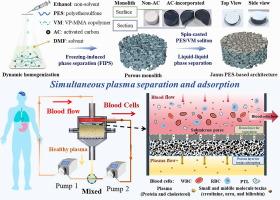基于 Janus PES 的结构将致密膜与多孔单片集成在一起,用于同时进行等离子分离和毒素吸附
IF 13.2
1区 工程技术
Q1 ENGINEERING, CHEMICAL
引用次数: 0
摘要
慢性肝功能衰竭(CLF)和慢性肾功能衰竭(CRF)会导致毒素积累,严重损害器官功能。为了应对这一挑战,我们开发了一种基于 Janus 聚醚砜(PES)结构的多孔单片集成致密膜,开创了一种同时分离血浆和吸附毒素的方法。采用冷冻诱导相分离(FIPS)技术制备的多孔整体膜具有约 83.3% 的高孔隙率和约 102.06 m2/g 的高比表面积。多孔整体石由聚醚砜和聚(乙烯基吡咯烷酮-甲基丙烯酸甲酯)两亲共聚物(VM)的聚合物网络以及活性炭组成。在各种单体中,PES18VM5C2 在吸附性和抗蛋白质粘附性之间达到了最佳平衡。在 PES18VM5C2 的顶部构建了具有可控亚微米孔径的 PES-VM 嵌入致密膜。致密膜能有效阻挡血细胞,而多孔单体则能有效吸附毒素。在两者的共同作用下,Janus 架构的 PES18VM5C2M16 可使超过 85% 的牛血清白蛋白 (BSA) 透过,充分展示了其选择性渗透能力。PES18VM5C2M16 集成到定制的 3D 打印支撑装置后,在 2 小时血浆吸附测试中,肌酐(67.6%)、尿酸(87.4%)和胆红素(89.1%)的清除率显著提高,而对总蛋白、白蛋白和胆固醇等基本血浆成分的影响则微乎其微。这项研究提出了一种 "Janus 接口结构 "作为下一代血浆分离和毒素吸附平台,为可穿戴式人工肝系统提供了一种前景广阔的策略。本文章由计算机程序翻译,如有差异,请以英文原文为准。

Janus PES-based architectures integrated dense membrane with porous monolith for simultaneous plasma separation and toxins adsorption
Chronic liver failure (CLF) and chronic renal failure (CRF) lead to toxins accumulation, severely impairing organ functions. To address this challenge, a Janus polyethersulfone (PES)-based architecture integrated dense membrane with porous monolith is developed, pioneering an approach for simultaneous plasma separation and toxins adsorption. The porous monolith, featuring high porosity about 83.3 % and substantial specific surface area about 102.06 m2/g, is prepared using the freezing-induced phase separation (FIPS) technique. The porous monolith is composed of polymer networks of PES and amphiphilic copolymer of poly (vinyl pyrrolidone-co-methyl methacrylate) (VM), as well as activated carbon. Among the various monolith, the PES18VM5C2 exhibits the optimal balance of adsorption and anti-protein adhesion. The PES-VM-incorporated dense membrane with a controlled submicron pore size is constructed atop the PES18VM5C2. The dense membrane effectively blocks hemocytes and the porous monolith efficiently adsorbs toxins. Together, the Janus architecture PES18VM5C2M16 allows over 85 % of bovine serum albumin (BSA) to permeate, showcasing its selective permeability. After being integrated into a custom 3D-printed supporting device, the PES18VM5C2M16 achieves significant clearance in creatinine (67.6 %), uric acid (87.4 %), and bilirubin (89.1 %) during 2-hour plasma adsorption test, with minimal impact on essential plasma components such as total protein, albumin, and cholesterol. This work presents a “Janus Interface Architecture” as next-generation platform for plasma separation and toxins adsorption, offering a promising strategy for wearable artificial liver systems.
求助全文
通过发布文献求助,成功后即可免费获取论文全文。
去求助
来源期刊

Chemical Engineering Journal
工程技术-工程:化工
CiteScore
21.70
自引率
9.30%
发文量
6781
审稿时长
2.4 months
期刊介绍:
The Chemical Engineering Journal is an international research journal that invites contributions of original and novel fundamental research. It aims to provide an international platform for presenting original fundamental research, interpretative reviews, and discussions on new developments in chemical engineering. The journal welcomes papers that describe novel theory and its practical application, as well as those that demonstrate the transfer of techniques from other disciplines. It also welcomes reports on carefully conducted experimental work that is soundly interpreted. The main focus of the journal is on original and rigorous research results that have broad significance. The Catalysis section within the Chemical Engineering Journal focuses specifically on Experimental and Theoretical studies in the fields of heterogeneous catalysis, molecular catalysis, and biocatalysis. These studies have industrial impact on various sectors such as chemicals, energy, materials, foods, healthcare, and environmental protection.
 求助内容:
求助内容: 应助结果提醒方式:
应助结果提醒方式:


